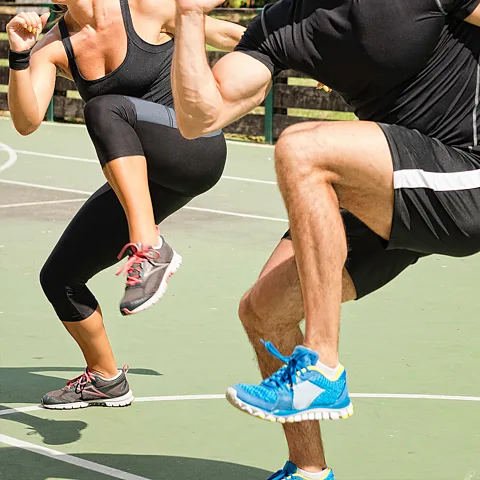Our knees are arguably one of our most important joints, but also one of the most poorly looked after. Science tells us putting in some work now pays dividends later.
You might start to notice it as early as your thirties: the dull knee aches when the weather changes, the morning stiffness when you get out of bed. You might think twice about crouching down. They’re all unwelcome signs that your knees are not quite the well-oiled joints they once were.
This will be especially true if you have a physical job or play a lot of sport. But it can be exacerbated by other things too. Weight gain, underlying autoimmune conditions and genetics can all accelerate the onset of knee problems.
But it’s also not surprising that our knees take a battering. Research indicates that just by walking, the force on your knees is already equivalent to one and a half times your body weight.
Five minutes to stay young
From reading a page of a book every day to knee-strengthening exercises, this series looks at simple lifestyle changes you can make now that will have a big impact on how you age. The best part? They all take around five minutes.
After back pain, throbbing aches in the knees are the most commonly cited musculoskeletal ailment in older adults, impacting everything from mobility to quality of life.
“The knee is one of the most complex joints in the entire body,” says Anikar Chhabra, an orthopaedic surgeon and chair of sports medicine at Mayo Clinic in Phoenix, US. “It bears the full load of our body weight with every step we take.”
There are assorted reasons for focusing on your knee health that can bring benefits both now and later in life, and a number of simple steps which we can all take to stay as mobile as possible for longer.
 Getty Images
Getty ImagesOur knees rely heavily on four surrounding muscle groups – the hamstrings, the gluteal muscles, the quadriceps muscles and the calf muscles. These support the knee and provide it with the stability and shock absorption capability that enables it to function.
“When these muscles aren’t interacting and working together, that’s when you put more stress on the joint,” says Chhabra. “That’s what leads to pain.”
Research has shown that strengthening these muscle groups through exercise can avoid degeneration of the cartilage in the knee which leads to osteoarthritis. This can either delay or prevent the need for knee replacement surgery. Some studies also indicate that keeping these muscles strong can decrease the load on the joint and reduce pain in people in the early stages of osteoarthritis.
Alexis Colvin, a professor of orthopaedic surgery at the Icahn School of Medicine at Mount Sinai in New York, US, explains that exercise can also improve the health of the cartilage cells themselves.
“There’s like a motor oil on the inside of our knees called synovial fluid,” she says. “Exercise helps stimulate production of it, which decreases stiffness and inflammation, and helps with lubricating the cartilage surface.”
Some exercises can also strengthen the knee bones themselves, reducing the risk of osteoporosis or bone thinning around the knee joint in later life. Knee strengthening can be particularly important for older adults, says Chhabra, as improving the stability of the surrounding muscles can reduce the risk of falls.
But knee exercises can have other surprising and often overlooked benefits such as improving proprioception – the subconscious awareness of where our body parts are in space. This “sixth sense” can help to improve our mobility and balance.
“Knee exercises help with this awareness,” says Chhabra. “It’s really getting your mind to connect to your knee which again will decrease risk of falls.”
Colvin says that it is never too early to begin working on strengthening your knees. While most research into the benefits of knee strengthening is done in older adults with existing osteoarthritis, studies carried out in adolescents who play a lot of sport have found that knee strengthening exercises, even at this young age, can play a big role in reducing risk of injury. For the rest of us, Colvin personally says she recommends beginning in your thirties.
“That’s when you start to very slowly lose muscle mass and bone density so that would be a good time to focus on it, if you don’t have strengthening as part of your regular exercise programme,” she says.
So what kinds of exercises should we be doing?
To keep the important muscle groups strong, Chhabra suggests spending 15 minutes a day, three to four times per week on various knee exercises listed below, all of which you can do at home without the need for any specialised equipment. He also recommends speaking to a physio or a strength coach first to ensure you are performing them correctly.
Here are five quick, home-based exercises which will all help. For all of these exercises, as a general rule, Colvin suggests starting with two sets of 10 reps, which means performing the exercise 10 times, resting, and then performing it another 10 times.
Step-ups
All this one requires is either a stair or a low step. Leading with your preferred foot, simply push up until both feet are on the step, and then back down again. When stepping up, alternate your lead foot each time.
“It’s low impact because it’s just body weight,” says Chhabra. “You’re building both your hamstrings and most importantly the quadriceps muscles in your front thighs. The quadriceps are the key to the knee joint in some ways, because when they’re weaker, the kneecap sits closer in, and you get more rubbing and pain.”
Weaker quadriceps also put more stress onto the joint where the kneecap glides over the thigh bone, causing pain and clicking.
Squats
Chhabra tells his patients that they should be doing squats every morning and every evening before they go to bed. “This works both the quads and the gluteal muscles, which are really critical to taking the stress off the knee joint,” he says. “It also helps with proprioception. Repeated body weight squats are very beneficial.”
For people who spend prolonged period of time sitting down, short bursts of 15 squats every 30 minutes have also been shown to encourage the body to produce the proteins needed to build muscle and strength.
Research shows that squatting can improve bone mineral density and reduce risk of falls in later life. While it’s not known whether they actively prevent the onset of arthritis, they’ve been shown to help stabilise the knee, reduce pain and improve quality of life in arthritis patients.
Chhabra has more concerns about deep squats, where you sink past a 90-degree bend in your knees, although the research community is split on the issue. Some studies show that provided the correct technique is used, there is no increased risk of injury. However, if done incorrectly, Chhabra says that they may worsen knee problems.
“This [can] put a lot of stress on the patellofemoral joint [the joint between the kneecap and the thigh bone] which causes more pain,” says Chhabra.
Straight leg raises
This is another simple exercise for strengthening the quadricep muscle. Lying on your back, bend the knee of one leg with your foot flat, while keeping the other leg straight and raising it a few inches off the ground, holding for a few seconds, before slowly lowering.
Research has shown that straight leg raises can improve the strength of the knee muscles and protect the joint, as well as reducing risk of exercise-related injuries when done as a warm-up exercise.
“The key with this exercise is that you want to contract our quadriceps muscle first,” says Colvin. “So while you’re straightening and raising the leg, you’re engaging the muscles that you’re targeting.”
Calf raises
Your calf muscle consists of two different muscles, the gastrocnemius and the soleus. Strengthening these is thought to be helpful in relieving stress from the part of the knee joint that’s below the kneecap.
Calf raises are one of the best ways of strengthening these muscles, according to Chhabra. Stand with your feet shoulder-width apart, toes pointing forward, and raise your heels slowly while keeping your knees extended, before holding for one second on the tips of your toes and then lowering again.
Calf raises help to improve the muscle balance around your knee so that they all work well together, he says. “If one muscle is weak, you’re going to have an imbalance which will put more strain on the knee.”
Getting up from a chair
This one works the core muscles deep within in your abdomen, back and pelvis. While they might not appear to be directly related, Colvin says that this large muscle group plays a somewhat underrated role in maintaining knee health. “Your core muscles really go from your mid chest down to your knee,” she says.
Simply sit in a chair and repeatedly stand up and sit back down again without holding onto anything.
“It’s definitely harder than you expect,” says Colvin. “And you can also make it harder either by getting a lower chair or doing it one-legged.”
If you’re new to doing these kinds of exercises, Chhabra recommends booking an initial appointment with either a physio or a strength and conditioning coach to first practice each one with them, to ensure you’re doing it correctly, and determine exactly how many sets and repetitions are appropriate for you.
“As you get stronger, you can certainly add weight, by doing some of these exercises wearing weighted vests, or holding weights if you have access to them, but that also depends on your age and your strength level,” he says. “As we get older, body weight alone tends to be best. I also tell patients to monitor worsening pain. Muscle soreness is normal, but worsening pain in the joints is not good, as that indicates something going on inside the knee that needs to be seen by a doctor.”
Overall, taking the time to do knee strengthening exercises serves as a valuable investment in your long-term health. We might take our knees for granted, but they let us walk, skip, jump and run, until they fail. As Baz Luhrmann wisely advised in the song Everybody’s Free (To Wear Sunscreen): “Be kind to your knees. You’ll miss them when they’re gone.”
Sourse: BBC







































